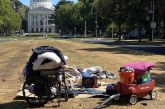

By David M. Greenwald
Davis, CA – Several years ago when I was on the Human Relations Commission, following the “Mowing While Black Incident,” I asked then-Assistant Chief Darren Pytel for the breakdown of police stops by race. At the time, he noted that, while he could produce that data, he felt that Davis had so many people coming in and out of town, it was difficult to create a baseline.
That same concern bleeds through in Darren Pytel’s response to Recommendation 1 of the Temporary Joint Subcommittee (TSJC) proposal: “Determine why racial disparities in arrests, recommended charges, and stops exist in Davis.”
Here he writes: “Of all of the recommendations in the report, this one is perhaps the most complex, with causal data difficult to isolate and interpret, and appropriate solutions even more perplexing. Looking at, analyzing, and responding to this and similar data will require continuous attention from law enforcement, including the Davis Police Department.”
Pytel continues, “In order for this data to be most meaningful to policymakers and law enforcement, a qualitative analysis should be included and data should be normalized, and compared to factors in addition to the estimated racial makeup of Davis residents. Having a more nuanced understanding of the data will more closely define actual disparities and allow for more targeted solutions.
“The issue is significantly more complicated than comparing the number of reportable stops or contacts to resident data,” he said, arguing that we do not “know the denominator” and, second, noted that “proportionality assumes that any arrest disparities must be due to bias alone and not some degree of differential offending.”
Instead, Pytel said, “There are, in fact, many studies that address differential offending as a result of disparities in very complex and intervening societal risk factors.”
With all due respect, I don’t think this issue is all that complex. We live in a town populated with people who are trained methodologists and, frankly, this isn’t asking for someone to do a  complex multi-variate regression analysis.
complex multi-variate regression analysis.
In fact, as I will argue, we actually have a lot of the data that the chief claims is missing—he is simply not looking in the right place.
This response suffers from two major problems. The first is Darren Pytel is clearly writing in a law enforcement silo and he is also writing in a Davis silo.
We actually have good data on who comes to town and, indeed, the Vanguard has been working with it in other contexts—mostly transportation and student housing—for several years. We have the UC Davis travel survey that shows every day during normal times at least about 28,000 people come to town on any given day, we also have the State of the City Report, that also shows a great deal of people coming into this community.
We also have a good deal of information about what those groups look like. The UC Davis students are slightly more diverse than the city as a whole—many more Asians, more Latinos, and about the same percentage of Blacks.
We may not know the exact denominator, but we have a reasonable estimate and if people are coming to town to, say, steal catalytic converters or otherwise committing some crime, that number is actually tiny compared to the tens of thousands coming to town each day to attend or work at the university.
And so, on a daily basis, we have a fairly good idea what the racial breakdown looks like in the city—perhaps a PhD student can do a more finely tuned assessment, but at the end of the day, we know racial disparities exist throughout the system and Davis is bit more skewed than the average community in California.
That gets me to the second problem with the data.
Pytel argues “proportionality assumes that any arrest disparities must be due to bias alone.” This is a classic error conflating individual bias with systemic racism.
There is a perception out there that the racial bias in the system is committed by individually biased individuals, whereas the reality is that systemic racism often bakes that bias into the system.
Radley Balko points out that “systemic racism” is often misinterpreted to mean “everyone in the system is racist. In fact, systemic racism means almost the opposite. It means that we have systems and institutions that produce racially disparate outcomes, regardless of the intentions of the people who work within them.”
The data in Davis bear this out.
“The percentage of Hispanic and Black arrestees in Davis over the 2015-19 period is strongly disproportionate to the population shares of these groups in the City, a finding which holds even when considering arrests of Davis residents only,” the joint subcommittee finds.
The numbers at the local level are stunning: “Black people are arrested at a rate 5.9 times more, and Hispanic people 1.5 times more, than their population share; when considering only Davis residents, Black people are arrested at 5.0 times and Hispanic people 1.4 times their population share.”
The joint subcommittee reports that both sets of figures far exceed the racial disparity in arrests in the United States as a whole—and I would add, are worse than the statewide average as well.
It goes further: “Similar racial inequalities hold with respect to the overall number of recommended charges filed by Davis Police Department (DPD) officers in the city, and Hispanic and Black people are also subject to traffic-related stops and searches at a much higher rate than their respective population shares in Davis (though roughly proportional to regional population shares).”
They recommend: “[A] detailed study of the determinants of racially disproportionate stops, arrests, and recommended charges in Davis, including an analysis of the relative contributions of potential bias in policing, potential bias in community reporting, and socio-economic factors. This will likely require a regional analysis in partnership with agencies from Yolo County and surrounding counties.”
We have a number of state and national studies on this.
National studies show that what is happening in Davis is not unique—though it may be more extreme.
A number of national studies show Blacks are more likely to be stopped and more likely to be searched—with a far lower percentage than whites of hits or contraband found when they are searched, implying that whites are stopped for evidence-based reasons, Blacks for biased reasons (see the Stop and Frisk data and also some of the larger police stop studies in multiple states).
The book Suspect Citizens came out in 2018, and it looked at data from North Carolina and found, “Blacks were 63 percent more likely to be stopped even though, as a whole, they drive 16 percent less. Taking into account less time on the road, blacks were about 95 percent more likely to be stopped.
“Blacks were 115 percent more likely than whites to be searched in a traffic stop (5.05 percent for blacks, 2.35 percent for whites),” they found.
And the incredible thing: contraband was more likely to be found in searches of white drivers.
Why is that? We think largely because Black drivers are being searched based on factors that have less to do with the probability of having contraband—they are more blanket searches, while whites are being searched because there is a specific reason to search them.
“So, black drivers were stopped disproportionately more than white drivers compared to the local population and were at least twice as likely to be searched, but they were slightly less likely to get a ticket,” Professor Kelsey Shoub, one of the authors, explained. “That correlates with the idea that black drivers were stopped on the pretext of having done something wrong, and when the officer doesn’t see in the car what he thought he might, he tells them to go on their way.”
They went beyond North Carolina as well. Shoub and her colleagues also analyzed stop data from 16 others states and found similar disparities.
We have local data in Davis and national studies such as the Shoub study which both are showing the same thing, but the analysis by Pytel completely avoids situating the Davis situation within a national context and within a context where we have a good and growing body of research.
My recommendation to council is to ask some methodology-trained students to work with the data and allow the council to take a research-based approach to these issues.
—David M. Greenwald reporting
To sign up for our new newsletter – Everyday Injustice – https://tinyurl.com/yyultcf9
Support our work – to become a sustaining at $5 – $10- $25 per month hit the link:






What was that incident? I’ve never heard of it.
The truly tiny number is those (of any skin color, on any day) who are actually pulled over/detained for any reason whatsoever.
And if there’s only (say) 10 black people within a much larger population, if even one of them is pulled-over on a given day the resulting “percentage” of black people pulled over will be skewed and misleading. And if even one is coming into town to “steal catalytic converters” (per the example in this article), then the results will be misleading.
Nowhere is this ever explained, by anyone. Other than examples such as slavery and Jim Crow laws, there are no systems which are racist in-and-of themselves.
Systems can only become racist if those who administer them do so in a (personally) racist manner.
There are systems which can have a disproportionate impact on one group or another, such as laws against crimes which are committed disproportionately by one group or another. And housing programs which limit residency to those with a pre-existing connection to a given town (which is not as diverse as the larger population), for example.
By the way, are the police required to record their perceptions/determination of the skin color of every one that they pull over?
“By the way, are the police required to record their perceptions/determination of the skin color of every one that they pull over?”
Yes.
Wait a minute, does that mean that when I’ve been pulled over in Davis, they have correctly identified me as a Jew rather than as a white person?
Must’ve been the matzo ball on the dash.
This is why a careful reading of my piece and the relevant research is important BEFORE you start commenting and arguing. Unfortunately, you argue first and ask questions later if at all.
Here is point one: “Black people are arrested at a rate 5.9 times more, and Hispanic people 1.5 times more, than their population share; when considering only Davis residents, Black people are arrested at 5.0 times and Hispanic people 1.4 times their population share.”
Now, if they were simply responding proportionately to criminal activity, then you may still have problems, but it might be justified.
But that’s why I brought in some of the studies which show very conclusively that’s not happening.
We know that Blacks are more likely to be stopped than whites. They are far more likely to be searched than whites. And the “hit” rate is lower. “contraband was more likely to be found in searches of white drivers.”
This is true locally and nationally. And that’s why you need to understand the data before commenting on this stuff.
Typical arrogance.
The basic problem with all of your “research” is that you draw unsupported conclusions regarding cause. Unfortunately, you are not alone in that. Your conclusions are based upon “beliefs”.
How many (in terms of actual numbers) of black people are stopped in Davis each year, and found to have no “contraband”? And, why are they being stopped in the first place, given that police are not stopping people for “suspected contraband”? Are they being stopped for other reasons, and then searched?
This is the (other) type of background data that one needs to know, before drawing any conclusions at all. There are likely many other factors, as well.
And, why is the system more “racist” against whites, than it presumably is against Asians? Why is the system less “racist” against Hispanics, than it is against blacks?
Both are good points. What good are methodologists if they let their biases enter into their conclusions?
“How many (in terms of actual numbers) of black people are stopped in Davis each year, and found to have no “contraband”? And, why are they being stopped in the first place, given that police are not stopping people for “suspected contraband”? Are they being stopped for other reasons, and then searched?
This is the (other) type of background data that one needs to know, before drawing any conclusions at all. There are likely many other factors, as well.”
These are good questions – but we have answers to them. They are in the reports. Why haven’t you read those reports?
And how would you know this: “The basic problem with all of your “research” is that you draw unsupported conclusions regarding cause.” If you haven’t read the reports?
Also can you show me what conclusion I have written here?
Do you read what you write?
That is an opinion/conclusion, not necessarily a “reality”.
It’s actually rather frightening, that a significant number of people are so ready to jump to that conclusion.
As far as what’s in the reports, go ahead and present it. I suspect that the number of black people stopped for “no reason” is exceedingly small. But regardless, it is not evidence for your conclusion.
I’m pretty comfortable with that conclusion – systemic racism exists in America.
Data does not support that as the only conclusion. Nor is the data “complete”. (One would have to examine crime statistics by skin color, gender, age, etc., for example.)
Staff noted similar issues (complexities) in their report.
You’re certainly aware of this, regardless of whether you want to acknowledge it.
Your preferred belief has the potential to create significant risks/problems. Unfortunately, you are not alone.
Also, nowhere is it explained (nor does it make any sense whatsoever, in terms of “systemic racism”)
So, we’re to conclude that the “system” is much more racist against black people, than it is against Hispanic people. Really?
Although arrest statistics are not provided, is the system also “less” racist against Asians, than it is against whites? If they are arrested less often than whites, is that what we’re to conclude from this? And shouldn’t we then break it down into the various Asian categories, to determine which of the categories experiences the most “systemic racism”?
And wanna be socialists . . .
Because you’re not 😐
The points raised by Ron O. are valid. There are limits to the conclusions one can draw from comparative data on stops, searches, and arrests because variables other than race are not accounted for or controlled. To determine if the hypothesis of systemic racism is the primary factor, one would likely have to conduct controlled experimental studies where other variables can be held constant—e.g., simulations where the only variable between experiment groups is race. Or, perhaps, testing studies such as is done to detect housing discrimination.
If there is a COPS show on Davis police, then everyone can judge case by case whether the police is doing it right or wrong. You can see from the footage whether the officer’s decision to stop someone is biased.
Another way to do this is to compare the data of an officer who make stop decision by himself versus an officer who makes stop decisions only on request.
For example, it could be a ridealong auditor who decides whether to investigate something suspicious, or that the officer only respond to calls from people reporting suspicious activity.
Then even if there is a bias, you can see that the bias is not from the police. But from the people making the complaints.
In a ridealong setting, both the officer and the auditor have decision power to atop a person. They are both making the decision without any retrospective knowledge.
Then you can compare the hit rate based on when the two people disagree on whether a person shall be stopped.